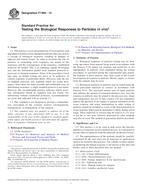Potrebujeme váš súhlas na využitie jednotlivých dát, aby sa vám okrem iného mohli ukazovať informácie týkajúce sa vašich záujmov. Súhlas udelíte kliknutím na tlačidlo „OK“.
ASTM F1904-14
Standard Practice for Testing the Biological Responses to Particles in vivo
Automaticky preložený názov:
Štandardný postup skúšania na biologickú odpoveď na častice in vivo
NORMA vydaná dňa 1.3.2014
Informácie o norme:
Označenie normy: ASTM F1904-14
Poznámka: NEPLATNÁ
Dátum vydania normy: 1.3.2014
Kód tovaru: NS-52032
Počet strán: 3
Približná hmotnosť: 9 g (0.02 libier)
Krajina: Americká technická norma
Kategória: Technické normy ASTM
Kategórie - podobné normy:
Anotácia textu normy ASTM F1904-14 :
Keywords:
biocompatibility, biological response, in vivo, interleukins, particles, ICS Number Code 11.040.40 (Implants for surgery, prothetics and orthotics)
Doplňujúce informácie
| Significance and Use | ||||||||
|
4.1 This practice is to be used to help assess the biocompatibility of materials used in medical devices. It is designed to test the effect of particles from the materials on the host tissues. 4.2 The appropriateness of the methods should be carefully considered by the user since not all materials or applications need to be tested by this practice. The validity of these studies in predicting the human response is not known at this time and studies such as those described here are needed. 4.3 Abbreviations Used: 4.3.1 CD—Cluster differentiation. 4.3.2 DNA—Deoxyribonucleic acid. 4.3.3 EDS—Energy dispersive X-ray spectroscopy. 4.3.4 EU—Endotoxin unit. 4.3.5 HLA—Human leukocyte antigens. 4.3.6 LAL—Limulus amebocyte lysate. 4.3.7 LPS—Lipopolysaccharide (endotoxin). 4.3.8 RNA—Ribonucleic acid. |
||||||||
| 1. Scope | ||||||||
|
1.1 This practice covers the production of wear particles and degradation products from implanted materials that may lead to a cascade of biological responses resulting in damage to adjacent and remote tissues. In order to ascertain the role of particles in stimulating such responses, the nature of the responses, and the consequences of the responses, established protocols are needed. This is an emerging, rapidly developing area and the information gained from standard protocols is necessary to interpret responses. Some of the procedures listed here may, on further testing, not prove to be predictive of clinical responses to particulate debris. However, only the use of standard protocols will establish which are useful techniques. Since there are many possible and established ways of determining responses, a single standard protocol is not stated. However, this recommended practice indicates which necessary information should be supplied with test results. For laboratories without established protocols, recommendations are given and indicated with an asterisk (*). 1.2 This standard is not designed to provide a comprehensive assessment of the systemic toxicity, carcinogenicity, teratogenicity, or mutagenicity of the material. 1.3 This standard does not purport to address all of the safety concerns, if any, associated with its use. It is the responsibility of the user of this standard to establish appropriate safety and health practices and determine the applicability of regulatory limitations prior to use. |
||||||||
| 2. Referenced Documents | ||||||||
|
Podobné normy:
Historická
1.12.2013
Historická
1.8.2009
Historická
1.1.2012
Historická
1.12.2011
Historická
1.10.2012
Historická
1.12.2011
Odporúčame:
Aktualizácia technických noriem
Chcete mať istotu, že používate len platné technické normy?
Ponúkame Vám riešenie, ktoré Vám zaistí mesačný prehľad o aktuálnosti noriem, ktoré používate.
Chcete vedieť viac informácií ? Pozrite sa na túto stránku.



 ASTM F601-13
ASTM F601-13 ASTM F602-09
ASTM F602-09 ASTM F603-12
ASTM F603-12 ASTM F620-11
ASTM F620-11 ASTM F621-12
ASTM F621-12 ASTM F629-11
ASTM F629-11
 Cookies
Cookies
